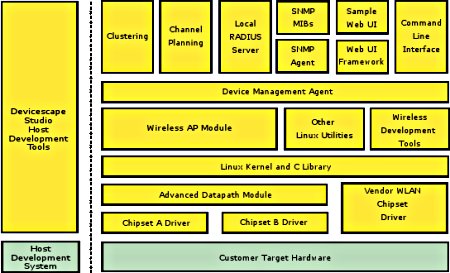Linux WiFi stack aims enterprise features at SMBs
Jun 27, 2005 — by Henry Kingman — from the LinuxDevices Archive — viewsDevicescape is shipping a commercial WiFi stack that it claims can bring enterprise management and security features to access points targeting the SMB (small-medium business), public safety, and other vertical markets. Wireless Infrastructure Platform 2.0 (WIP) includes a complete yet customizable Linux access point distribution, tools, documentation, and support.
According to Devicescape VP of Marketing Glenn Flinchbaugh, WIP includes everything needed by OEMs (original equipment manufacturers) and ODMs (original design manufacturers) to build WiFi access points with enterprise features. “An OEM or ODM could rebrand it and have a competitive enterprise access point,” Flinchbaugh says.
For customers wishing to add differentiating or customizing features, WIP comes with Eclipse-based development tools, as well as modular, well-documented APIs and libraries that let users pick and choose features to include, Flinchbaugh says. Total footprint size, including an embedded Linux operating system and all modules, is just under 8MB of Flash, and 16MB of RAM.

WIP's modular architecture
WIP also comes with support from Devicescape, which used to focus exclusively on professional services prior to changing its name from Instant802 in February and adopting more of an off-the-shelf product-focused business model, around products such as its Universal Wireless Platform for WiFi clients.
Flinchbaugh says WIP implements several advanced features previously found only in enterprise-class access points. These include:
- Support for WPA2 (WiFi protected access 2) — “WPA2 requires Radius authentication. Most small- and medium-sized business don't happen to run a Radius server, so we added one to the device,” explains Flinchbaugh.
- Channel planning — WIP-based access points form clusters and share information to avoid channel conflicts using a distributed algorithm, achieving functionality that usually requires an expensive wireless LAN switch or management system, Flinchbaugh says.
- Load balancing — WIP-based access points share information about utilization, and attempt to distribute users evenly among available access points — again, something usually done in management systems or wireless LAN switches, according to Flinchbaugh.
- auto-configuration — The first WIP-based access point must be configured manually, after which additional devices learn their configuration automatically. Additionally, a change to the configuration of one access point can be propagated to other access points, Flinchbaugh says.
Additional features of WIP include:
- 2.4.27 Linux kernel
- Supports ARM/Xscale, MIPS, PowerPC, IA-32
- uClib small-footprint C library
- Field-upgradable
- TCP/IPv4, DHCP, ARP, RARP, TFTP, FTP, NTP, NFS, VLAN, PPPoE, RIP
- SSL/SSH, HTTPS, IPSec
- IP filtering firewall
- cramfs, jffs2, genext2fs
Supported hardware platforms include:
- Intel MonteJade with IXP425
- Novatec NTNP425C with IXP425
- D-Link DWL2210-AP with AR2313 SOC
- Atheros AP51 with AR2315/6 SOC
- Broadcom BCM94712 with BCM4712 SOC
- Engim AP-310 Reference AP with PPC
- Embedded Planet EP8245 with Freescale
MPC8245 - Intel IA-32 PC for simulation
Supported WiFi chipsets include:
- Atheros — AR5213, AR2312/3, AR2315/6, AR5312, AR2413/4, AR5413/4
- Broadcom — BCM4306, BCM4309, BCM4712
- Engim — 3001 b/g
Flinchbaugh explained, “We're very heavily focused on Linux and open source software when it comes to access point designs. For example, we use the Clearsilver (link) interface abstraction system, which separates content from presentation and allowed us to easily create a Japanese version. We also use OpenSSL, GNU cross-development tool, and Eclipse.”
Devicescape CEO David Fraser added, “The promise of a world without wires can only be fulfilled when building networks and connecting devices to them is as easy as plugging a phone into a jack. With Devicescape WIP, device manufacturers can now make it possible for any organization to very simply build and manage a secure wireless network, the first critical step to establishing a devicescape.”
This article was originally published on LinuxDevices.com and has been donated to the open source community by QuinStreet Inc. Please visit LinuxToday.com for up-to-date news and articles about Linux and open source.